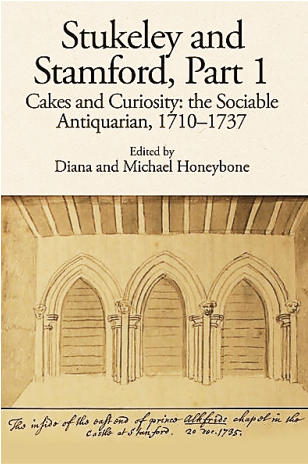Stukeley and Stamford, Part I -
Cakes and Curiosity: the Sociable Antiquarian, 1710-1737
By Diana and Michael Honeybone (editors)
Lincoln Record Society, Volume 109, 2021. 312 pages.
Published for the Society by Boydell & Brewer.
ISBN 978-1-9106-5307-4, ISSN 0267-2634
Lincolnshire
native
William
Stukeley
(1687–1765)
was
a
leading
antiquarian
who
lived
at
Stamford
between
1730
and
1740
as
the
vicar
of
All
Saints
Church.
This
latest
volume
in
the
long-standing
Lincoln
Record
Series
is
a
handsomely
produced
hardback
with
a
comprehensive
text
and
extensive
footnotes,
as
one
might
expect
from
these
editors
and
this
society.
A
fulsome
introduction
leads
the
reader
to
the
annotated
text,
accompanied
by
very
helpful
and
insightful
commentary
and
appendices
of
three
of
Stukeley's
works:
The
Iter
Oxoniense
(1710);
Stanfordia
Illustrata (1735-6) and the Minutes of the Brazen Nose Society of Stamford (1736-7).
This
book
is
an
important
contribution
to
the
study
of
Stukeley
and
eighteenth
century
antiquarianism
as
well
as
that
of
the
developing
appreciation
of
Stamford's
history
in
that
time.
Stukeley
visited
and
wrote
about
a
confederate
of
Rutland
residents
including
Samuel
Barker,
William
Whiston,
and
Tycho
Wing,
who
are
all
mentioned
in
the
text.
Stukeley
also
visited
Ryhall,
Great
Casterton,
Woodhead,
Belmes-thorpe
and
Tolethorpe,
in
the
east
of
Rutland,
all
of
which
are
mentioned
in
the
text,
together
with
an
interesting
commentary
on
Tickencote
church
before
restoration.
Although
those
who
are
interested
in
Rutland
will
look
forward
to
the
same
authors'
article
on
Stukeley's
excursions
in
our
county
in
the
forthcoming
Rutland
Record
42,
some
may
wish
to
supplement
their
understanding
of
the
man
and
his
sojourn locally by reference to this book.
Dr Hilary Crowden

Researching Rutland
Copyright © Rutland Local History and Record Society. - All rights reserved
Registered Charity No 700273


Book Review



Researching Rutland
© Rutland Local History and Record Society
Registered Charity No 700273

Book Review
William Browne’s Town: The Stamford Hall Book 1465-1492
Stamford Survey Group in association with Stamford Town Council and
Stamford Civic Trust
Stamford is fortunate to have a Hall Book, a record of the council minutes
of the town. Until now it has remained in the town’s archives only to be
seen by historians with an appointment. With this transcript Alan Rogers
has made the first part of the Hall Book accessible to all and we are given
the opportunity to step back in time and discover what life was really like
in the fifteenth century. Future volumes are planned which will continue
the story of Stamford’s town affairs.
The book gives a remarkable insight into the lives of townspeople in
medieval England covering the years from 1465, shortly after the town’s
incorporation, until 1489 just after the death of William Browne. William
Browne was a very rich and important Merchant of the Staple. He
controlled the affairs of the town during this period, serving as Alderman
on several occasions. His legacy to Stamford is All Saints’ Church and
Browne’s Hospital.
As today, rules and regulations governed the lives of townsfolk. The
minutes record laws forbidding Sunday trading and fines for leaving
horses tied up in the wrong places on market days – as the editor
comments, ‘There were parking penalties even in medieval Stamford’. We
also find that there were designated places for dunghills and times when
animals could be brought into town. From this book we learn how law
and order was enforced and the punishments meted out to wrongdoers.
Perhaps the most interesting aspect of the volume is the tremendous
number of different trades pursued in the town. The wardens strictly
controlled the craftsmen to ensure the quality of goods and there was a
diversity of rules governing the guilds and the pageant of Corpus Christi.
Alan Rogers has had close links with Stamford and readers will no doubt
be familiar with his books The Medieval Buildings of Stamford
(Nottingham 1970), The Book of Stamford (Buckingham 1983) and, with
JS Hartley, The Religious Foundations of Medieval Stamford
(Nottingham 1974). He has also been closely involved with local history in
Rutland, most recently in Uppingham, inspiring and encouraging local
historians to record aspects of the history of that town.
For this volume Professor Rogers has written an excellent introduction
including the insight he has gained about the role of William Browne in
making the transcript. He also adds useful comments throughout the
volume and there is an excellent index. It is a shame that the Editorial
Conventions are not at the front of the book and a glossary would have
been useful for those less familiar with the legal terms of the medieval
period. Do not however be deterred by the plain cover: inside it is a
fascinating record not just for people in Stamford but for anyone
interested in town life in the Middle Ages. It is a book to dip into, and read
aloud it comes to life. It certainly merits a place on the bookshelf of
anyone interested in history.
Jean Orpin







